| 1 | The world’s worst invasive snake |
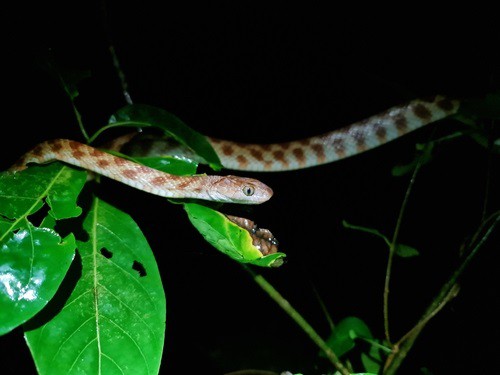
The brown tree snake is part of the 42 member Boiga catsnake family, named for their nocturnal habits and vertical slits of pupils. At 1-2 metres, this is one of the largest members. Brown tree snakes (Boiga irregularis) are most commonly found in the forests of northern Australia, including Queensland and Northern Territory, and are the only Boiga catsnake to inhabit Australia. Their other natural territories include New Guinea, Sulawesi, and several small Melanesian islands.
In their natural realms, brown tree snakes aren’t especially interesting, except for a bizarre lasso method they use for climbing. But it’s the unnatural we’re interested in, as since the 1940s, Boiga irregularis has been the single most destructive invasive snake in the world. The land they’ve invaded is Guam, a Pacific island measuring 200 square miles, located 1500 miles south of Tokyo.
This island has no native snake species, but the brown tree snake has multiplied so rapidly that its population is an estimated 2 million. There’s an estimated 13,000-30,000 per square mile, and the result has been a catastrophic decline in the bird population. Because of the brown tree snake, 10 out of 12 of Guam’s forest bird species are now extinct, and 2 are severely reduced.
| 2 | Decimating Guam’s birds |
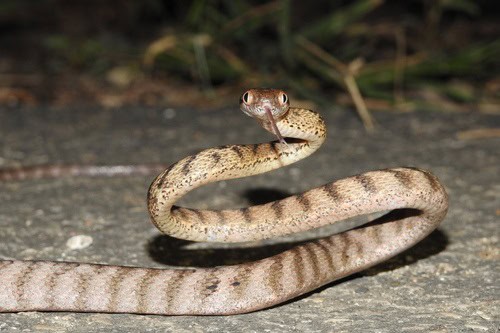
The island of Guam is 50km long and 10km wide. Officially, it is classed as a US Territory, similarly to Puerto Rico or American Samoa. The island was captured by the Japanese on December 8th 1941, mere hours after the attacks on Pearl Harbour. The US recaptured the island on July 21st 1944, following 2.5 years of all-out war.
US troops have held Guam ever since, except for one stealthier invader which has sneaked through their defences. The first brown tree snake is believed to have been transported in the late 1940s, via cargo shipments of US military equipment.
It’s believed that the snake stowaways boarded on Manus island, north of Papua New Guinea, part of the species’ native range, but another theory is that they shipped with troop carriers from Australia. Either way, Guam locals first reported snake sightings in the early 1950s, near the village of Santa Rita, adjacent to the US Naval port facility.
| 3 | Wiping out many species |
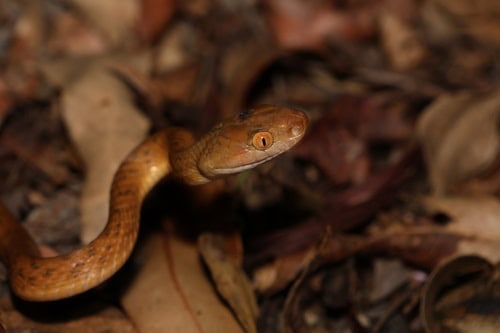
In the 1970s, locals noticed that the abundant birds on Guam were beginning to become scarce. Disease and pesticides were proposed, but it wasn’t until 1987 that the invasive brown tree snake was declared responsible. The decline in numbers was synchronised, happening to all birds species at once, with the worst declines from 1976 to 1986.
Brown tree snakes were suddenly everywhere, covering the whole island. One species to go extinct was the Guam flycatcher, which had a long beak with special whiskers which helped it to hunt. Guam flycatchers were abundant on Guam as recently as the 1970s, but were last officially sighted in 1983. The bird was secretive, and occurred in deep limestone and ravine forests.
Brown tree snakes average at 100-200cm, but because of the buffet of birds they enjoyed on Guam, they ballooned to jumbo sizes, with the largest of all time reaching 3 metres. Brown tree snakes don’t ignore chickens either, and poultry farmers have suffered. While a strongly arboreal snake, clinging to branches for hours, brown tree snakes also venture to the ground on exploratory hunting expeditions, including into chicken coops.
| 4 | Now causing constant powercuts |
Brown tree snakes are hard to eradicate partly because they’re active at night, reducing encounters with humans. They’re experts at disappearing into tangled forests, a relic from their natural ranges where they actually have predators.
It isn’t just birds either. Brown tree snakes are acrobats, and have a tendency to climb pylons and slither along power lines, like a tightrope, and even into transporters. This causes an average of 1 powercut in Guam every 4 days, costing an estimated $1 million annually. These power outages affect military bases as well as private households (perhaps the Japanese released them originally).
Boiga irregularis has also added a feeling of danger to Guam. They’re an aggressive species which hisses and lunges at anyone that dares to invade their personal space. Over 200 Guam citizens have been hospitalised for snakebites in recent decades. No deaths have occurred, but in infants, some bites have been life-threatening.
A 1990 report detailed 4 young children who were bitten in their beds while sleeping at night. 2 young infants developed respiratory problems, requiring ventilation for asphyxiation. Other symptoms included swelling, discolouration, and neurotoxic symptoms such as altered sensory perception and drooping eyelids. Because of their agility, brown tree snakes are experts at entering houses via air vents and sewage ducts, or open windows.
| 5 | The horror deepens: spider overload |
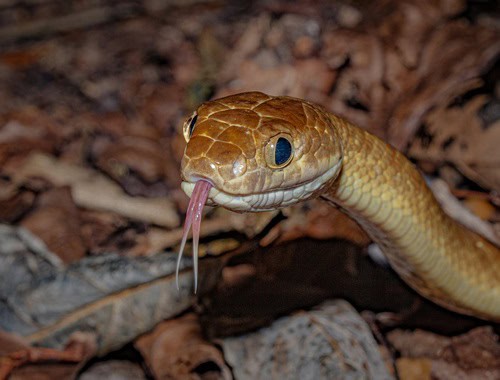
The brown tree snake invasion has had all sorts of strange consequences. Walking through a Guam forest now leaves your face covered with spider’s webs, as there are no birds to prey on the spiders themselves. Thanks to the brown tree snake, Guam is now an arachnophobe’s worst nightmare. It’s estimated that there’s 40 times more spiders on Guam compared to nearby islands.
When Guam’s mangrove and thorny forests were compared to those in nearby Saipan, the numbers of mature trees were found to be equal, yet the seedlings were 50 times higher in Saipan. On Guam, 94-96% of seeds landed directly below their parent tree, achieving nothing. On Saipan, the figure was 26-40%.
By removing birds, the seeds are no longer being spread. Instead, Guam’s trees are covered with ants, butterflies, rodents, lizards and caterpillars. One study estimated that new tree growth has declined by 92% on Guam. Then there’s the island’s audio. On nearby Saipan, you walk along amid constant bird chatter. All is well in the forest. Then you walk through Guam and it’s silent. The birds are all dead. The island is a tomb.
| 6 | Small children aren’t safe |
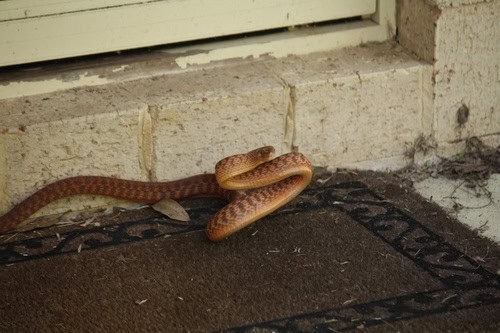
Brown tree snakes are especially successful stowaways in cargo ships, because they can go for months without food. 3000 miles away, Hawaiian officials are terrified by the snake landing on their shores, as there are regular military flights between Hawaii and Guam. A 2010 study found that brown tree snakes could cause between $593 million and $2.14 billion worth of economic damage if they became established on Hawaii. It would only take one pregnant female to dart into the undergrowth, through an airport official’s outstretched fingers.
One study found that Guam suffered an average of 137 power outages annually from 1991 to 1997, specifically due to brown tree snakes. The absolute nightmare scenario would be if they docked on the US west coast. Luckily, there are no direct flights from the US mainland to Guam, only from Hawaii.
In 1992, the Department of Defence was granted $2 million to eradicate Boiga irregularis, and in 1990, an act of congress specifically ordered their eradication. So far all attempts have failed. Brown tree snakes are slightly less common in 2024 than 1990, but they cover every inch of Guam and their density is incredible.
| 7 | Only declining slightly |
The forests of Australia and New Guinea are also filled with birds, so why was Guam so decimated? The difference is that Guam lacked any native snakes. Hence, the native birds lacked any defensive instincts against them. They had no idea what do when they saw a hungry snake coming. They didn’t even realise there was a threat.
It’s like penguins on Antarctica, which have no land predators, and allow humans to walk among them with no fear. In Australia, the native birds squawk, peck and flap at snakes with a mad frenzy. Brown tree snakes also have no natural predators on Guam except for the Mariana monitor, and feral pigs. There was nothing to control their numbers.
The population of brown tree snakes on Guam is now believed to be declining, but only because they’ve devoured almost all the available bird prey. At its peak, the population was 100 snakes per hectare, whereas the currently estimate is 30-50 per hectare, still far too high to eradicate via simple hack and slash methods.
| 8 | Next stop: Hawaii? |
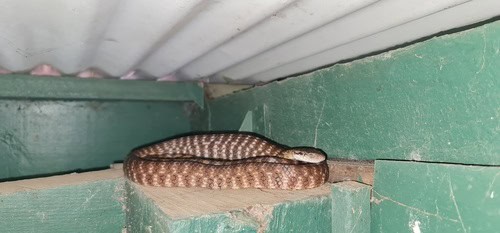
As of 2009, Honolulu airport in Hawaii had intercepted brown tree snakes six times, so far preventing them from establishing a population. Sniffer dogs are regularly deployed, and cargo shipments are fumigated with methyl bromide to poison any stowaways inside. Dogs are also deployed before cargo ships leave Guam.
In 1990, everyone’s nightmares came true. Brown tree snakes were spotted around Saipan’s main port, and a population was believed to be established. From 1990 to 2000, there were seven officially confirmed sightings, and in 2004, Saipan’s rare golden-white eye was declared critically endangered.
Whether they still exist there is a mystery, but they evidently haven’t taken over like on Guam, as 2000 remains the last officially confirmed sighting. In 2016, biosecurity officials dashed to Saipan’s main airport and the nearby town of Dandan, after two highly publicised sightings, Again, there was no confirmation. It’s now been 24 years since the last official sighting, and it’s believed that rapid crackdowns have contained the spread.
| 9 | Mice to the rescue |
One of the most daring schemes to wipe out brown tree snakes happened in 2013. It was like a crackpot deniable World War 2 operation – planes would fly over Guam at low levels and drop in 2000 mice soldiers. Except that these mice would be dead, and each laced with 80mg of paracetamol.
Each package had a biodegradable parachute designed to snag on branches, to place them right in the snakes’ paths. If the wrong species ate them, there was still no worry. Snakes are unusually sensitive to paracetamol, and it would take 15 times the dosage in the mice to kill a pet cat. The US military installed tiny radio devices into the mouse packages to track the operation.
The thinking was that they’d use the brown tree snakes’ flexible nature against them, as this is a necro snake which is perfectly willing to eat carrion (dead prey). 2000 mice were dropped, in an area limited to Andersen Air Force Base. PETA was angry at the plan, shouting cruelty, arguing that the plan would give the snake’s renal and liver failure. The US army argued that that was the whole point.
A similar mouse drop happened on military land in 2010, and was deemed successful. Another operation happened in 2016 in a small forest plot, and was also deemed successful.
| 10 | 2024: still firmly in control |
That said, a more recent scheme ended in complete failure. In 2020, brown tree snakes had finally reached Cocos island, just 2.5km south of Guam, considered to be many of the native birds’ last refuge.
Scientists installed bait boxes containing dead mice, again laced with acetaminophen, and with time-lapse monitoring to confirm whether the snakes took the bait. The baits were placed in various locations, such as on the ground, in trees, and in a system with 4 clear plastic tubes. There were also cage traps placed around the island, containing live mouse lures.
The results were conclusive: not a single brown tree snake took the necro bait. Only one brown tree snake slithered into a trap.
The scientists knew by hand counting that Boiga irregularis was plentiful in the area. So they were forced to reluctantly concede that their baiting method was a failure. They blamed the high abundance of geckos and birds on Cocos Island, which neutered any interest the snakes had in the dead mice. It’s possible that the 2013 Guam scheme was less effective than the US army admitted as well.
As of 2024, brown tree snakes are in complete control of Guam, and will remain so in perpetuity.

bring in king snakes..any of the Kingsnake …better a island of nice gentle non venomous snakes than poison ones